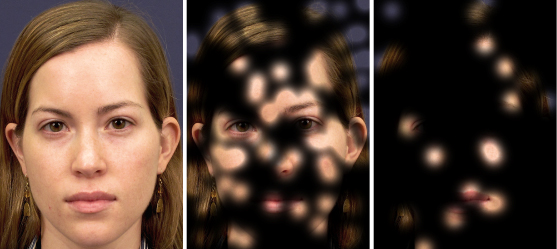Surprising responses to faces from single neurons in the amygdala
September 30, 2011
Which one of the two images on the right do you respond to?

This figure shows the kind of stimuli used in the study: whole faces (left) and only partly revealed faces. According to the researchers, the surprising finding was that although neurons respond most strongly to seeing the whole face, they actually respond much less to the middle panel than to the far right panel, even though the middle panel is more similar to the whole face. (Credit: Ralph Adolphs, California Institute of Technology)
Neurons in the the amygdala portion of the brain respond strongly when a person sees an entire face, but respond much less to a face in which only a very small region has been erased, neuroscientists from the California Institute of Technology (Caltech) have discovered by looking at recordings from brain cells in neurosurgical patients.
“The finding really surprised us,” says Ueli Rutishauser, first author on the paper, a former postdoctoral fellow at Caltech, and now a visitor in the Division of Biology. “Here you have neurons that respond well to seeing pictures of whole faces, but when you show them only parts of faces, they actually respond less and less the more of the face you show. That just seems counterintuitive.”
The neurons are located in a brain region called the amygdala, which is important for the processing of emotions. However, the study results strengthen a growing belief among researchers that the amygdala has also a more general role in processing and learning about social stimuli such as faces.
Neurons seem to prefer a Gestalt
“Our interpretation of this initially puzzling effect is that the brain cares about representing the entire face, and needs to be highly sensitive to anything wrong with the face, like a part missing,” explains Ralph Adolphs, senior author on the study and Bren Professor of Psychology and Neuroscience and professor of biology at Caltech. “This is probably an important mechanism to ensure that we do not mistake one person for another and to help us keep track of many individuals.”
The team recorded brain-cell responses in human participants who were awaiting surgery for drug-resistant epileptic seizures. As part of the preparation for surgery, the patients had electrodes implanted in their medial temporal lobes, the area of the brain where the amygdala is located.
The team plans to continue their studies by looking at how the same neurons respond to emotional stimuli. This future work, combined with the present study results, could be valuable for understanding a variety of psychiatric diseases in which this region of the brain is thought to function abnormally, such as mood disorders and autism.
Ref.: Ueli Rutishauser, et al., Single-Unit Responses Selective for Whole Faces in the Human Amygdala, Current Biology, 2011; [DOI:10.1016/j.cub.2011.08.035]